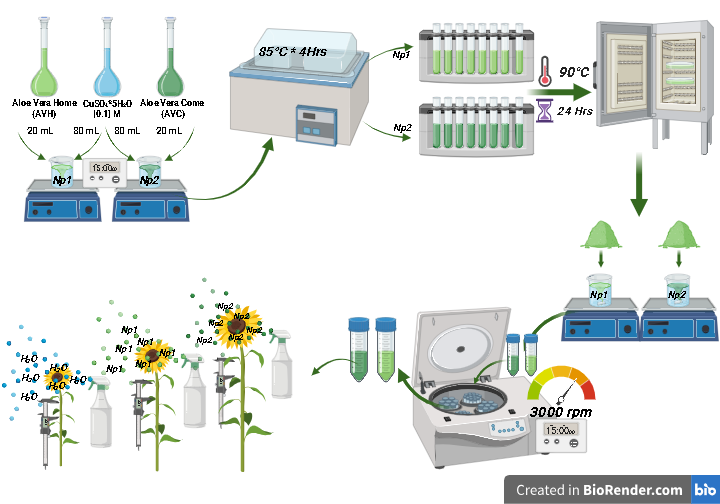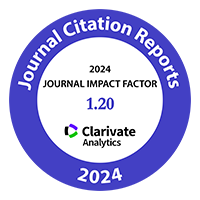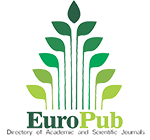Green Synthesis and Foliar Application of Copper Nanoparticles in Sunflower (Helianthus annuus L.) to Improve Physiological Parameters and Yield
Palabras clave:
fisiología vegetal, cultivos oleaginosos, tecnología agraria , agente reductor, ciencias de los cultivosResumen

Nanotechnology holds significant interest across various domains, including agriculture. The green synthesis of nanoparticles offers environmentally friendly solutions. This study aimed to synthesize copper nanoparticles (NPs) using Aloe vera extracts and evaluate their foliar application on two sunflower hybrids, Chané (Ch) and Calchaquí (Ca). The two types of Aloe Vera extracts used to produce nanoparticles were characterized by UV-vis spectral analysis and dynamic light scattering (DLS). The Np particles synthesized with Aloe vera Home (Np1) measured 242.8 nm (62.6%) and 74.87 nm (37.4%), while Aloe vera Commercial (Np2) resulted in sizes of 339.6 nm (90.7%) and 66.07 nm (9.3%). Two different doses of Np (150 ppm and 300 ppm) were applied to sunflower plants. We measured germination power (GP), plant height (PH), leaf number (LN), leaf area (LA), dry weight accumulation and achene yield. Chané’s parameters improved at both nanoparticle doses, while Calchaquí only improved with the 300 ppm treatment. This research highlights the potential use of green nanotechnology to improve growth and yield in sunflower.
Highlights:
- Nanoparticles, with unique physicochemical properties, have garnered significant attention in crop management strategies.
- Aloe vera, popular for its medicinal and bioactive properties, is a compelling candidate for synthesizing copper nanoparticles, aligning with sustainable practices and offering biocompatible and eco-friendly nanomaterials for agriculture.
- Sunflower (Helianthus annuus) is an emblematic oilseed crop known for its adaptability to various environments and the capacity to provide oil, seeds, and biomass.
- This research aims to describe the mechanisms underlying nanoparticle-plant interactions, and how Aloe Vera-based copper nanoparticles affect growth, biomass accumulation and partitioning in two sunflower hybrids.
- The Np particles synthesized with Aloe vera Home (Np1) measured 242.8 nm (62.6%) and 74.87 nm (37.4%), while Aloe vera Commercial (Np2) resulted in sizes of 339.6 nm (90.7%) and 66.07 nm (9.3%).
- Chané's parameters improved at both nanoparticle doses (150 ppm and 300 ppm), while Calchaquí showed only improved with the 300 ppm treatment.
Descargas
Citas
Aguilar, L.; Escalante, J.; Fucikovsky, L.; Tijerina, L.; Engelman, E. 2005. Leaf Area, Net Assimilation Rate, Yield and Plant Density in Sunflower. Terra Latinoam. 23: 303-310.
Aguirrezábal, L. A. N.; Lavaud, Y.; Dosio, G. A. A.; Izquierdo, N. G.; Andrade, F. H.; González, L. M. 2003. Intercepted Solar Radiation during Seed Filling Determines Sunflower Weight per Seed and Oil Concentration. Crop Sci. 43: 152-161. https://doi.org/10.2135/cropsci2003.1520
Alishah, H.; Pourseyedi, S.; Ebrahimipour, S. Y.; Mahani, S. E.; Rafiei, N. 2017. Green synthesis of starch-mediated CuO nanoparticles: preparation, characterization, antimicrobial activities and in vitro MTT assay against MCF-7 cell line. Rend. Lincei. 28: 65-71. https://doi. org/10.1007/s12210-016-0574-y
Aminuzzaman, M.; Kei, L. M.; Liang, W. H. 2017. Green synthesis of copper oxide (CuO) nanoparticles using banana peel extract and their photocatalytic activities. AIP Conf. Proc. 1828. https:// doi.org/10.1063/1.4979387
Céccoli, G.; Eugenia Senn, M.; Bustos, D.; Ismael Ortega, L.; Córdoba, A.; Vegetti, A.; Taleisnik, E. 2012. Genetic variability for responses to short- and long-term salt stress in vegetative sunflower plants. J. Plant Nutr. Soil Sci. 175: 882-890. https://doi.org/10.1002/jpln.201200303
Céccoli, G.; Bustos, D.; Ortega, L. I.; Senn, M. E.; Vegetti, A.; Taleisnik, E. 2015. Plasticity in sunflower leaf and cell growth under high salinity. Plant Biol. 17: 41-51. https://doi.org/10.1111/ plb.12205
Céccoli, G.; Granados Ortiz, S. A.; Buttarelli, M. S.; Pisarello, M. L.; Muñoz, F. F.; Daurelio, L. D.; Bouzo, C. A.; Panigo, E. S.; Perez, A. A. 2022. Salinity tolerance determination in four sunflower (Helianthus annuus L.) hybrids using yield parameters and principal components analysis model. Ann. Agric. Sci. 67: 211-219. https://doi.org/10.1016/j. aoas.2022.12.005
Chowdhury, R.; Khan, A.; Rashid, M. H. 2020. Green synthesis of CuO nanoparticles using: Lantana camara flower extract and their potential catalytic activity towards the aza-Michael reaction. RSC Adv. 10: 14374-14385. https://doi.org/10.1039/d0ra01479f
Darroudi, M.; Ahmad, M. B.; Abdullah, A. H.; Ibrahim, N. A.; Shameli, K. 2010. Effect of accelerator in green synthesis of silver nanoparticles. Int. J. Mol. Sci. 11: 3898-3905. https://doi.org/10.3390/ijms11103898
Fayyaz-Ul-Hassan; Qadir, G.; Cheema, M. A. 2005. Growth and development of sunflower in response to seasonal variations. Pakistan J. Bot. 37: 859-864. https://doi.org/10.2298/ hel0542159f
Flagella, Z.; Giuliani, M. M.; Rotunno, T.; Di Caterina, R.; De Caro, A. 2004. Effect of saline water on oil yield and quality of a high oleic sunflower (Helianthus annuus L.) hybrid. Eur. J. Agron. 21: 267-272. https://doi.org/10.1016/j.eja.2003.09.001
Gonzalez, M. A.; Bernardo, V.; Garita, S.; Plaza Cazón, J.; Arango, C.; Hernández, M. P.; Ruscitti, M. 2024. Morphophysiological and biochemical responses of Schedonorus arundinaceus to Zinc (II) excess: insights from biomarkers and elemental accumulation. Revista de la Facultad de Ciencias Agrarias. Universidad Nacional de Cuyo. Mendoza. Argentina. 56(2): 34-47. DOI: https://doi.org/10.48162/rev.39.135
Gunalan, S.; Sivaraj, R.; Venckatesh, R. 2012. Aloe barbadensis Miller mediated green synthesis of mono-disperse copper oxide nanoparticles: Optical properties. Spectrochim. Acta - Part A Mol. Biomol. Spectrosc. 97: 1140-1144. https://doi.org/10.1016/j.saa.2012.07.096
Hernández-Fuentes, A. D.; López-Vargas, E. R.; Pinedo-Espinoza, J. M.; Campos-Montiel, R. G.; Valdés-Reyna, J.; Juárez-Maldonado, A. 2017. Postharvest behavior of bioactive compounds in tomato fruits treated with Cu nanoparticles and NaCl stress. Appl. Sci. 7: 1-14. https:// doi.org/10.3390/app7100980
Jayarambabu, N.; Akshaykranth, A.; Venkatappa Rao, T.; Venkateswara Rao, K.; Rakesh Kumar, R. 2020. Green synthesis of Cu nanoparticles using Curcuma longa extract and their application in antimicrobial activity. Mater. Lett. 259: 126813. https://doi.org/10.1016/j. matlet.2019.126813
Lastochkina, O. V.; Garipova, S. R.; Pusenkova, L. I.; Garshina, D. Y. 2023. Effect of Endophytic Bacteria Bacillus subtilis on Seedling Growth and Root Lignification of Pisum sativum L. under Normal and Sodium Chloride Salt Conditions. 70: 1-11. https://doi.org/10.1134/ S102144372360085X
Lira Saldivar, R. H.; Méndez Argüello, B.; Vera Reyes, I.; de los Santos Villarreal, G. 2018. Agronanotechnology: A new tool for modern agriculture. Revista de la Facultad de Ciencias Agrarias. Universidad Nacional de Cuyo. Mendoza. Argentina. 50(2): 395-411. https://revistas.uncu.edu.ar/ojs3/index.php/RFCA/article/view/3067
Liu, C.; Cui, Y.; Pi, F.; Cheng, Y.; Guo, Y.; Qian, H. 2019. Extraction, purification, structural characteristics, biological activities and pharmacological applications of acemannan, a polysaccharide from Aloe Vera: A review. Molecules 24. https://doi.org/10.3390/ molecules24081554
Maya-Meraz, I, O.; Díaz-Calzadillas, M. F.; Ruiz-Cisneros, M. F.; Ornelas-Paz, J. de. J.; Rios-Velasco, C.; Berlanga-Reyes, D. I.; Pérez-Corral, D. A.; Alonso-Villegas, R. 2024. Effects of postharvest treatments based on calcium and silicon in hydro-cooling on the basic quality attributes of ʹBingʹ sweet cherries (Prunus avium L.) during storage. Revista de la Facultad de Ciencias Agrarias. Universidad Nacional de Cuyo. Mendoza. Argentina. 56(2): 114-125. DOI: https://doi.org/10.48162/rev.39.142
Mesquita, A. C.; Lima Simões, W.; Alcantara Campos, L. D.; Braga, M. B.; Alves Sobral, Y. R. 2024. Gas exchange in yellow melon (Cucumis melo) crop under controlled water deficit (RDI) and application of a biostimulant. Revista de la Facultad de Ciencias Agrarias. Universidad Nacional de Cuyo. Mendoza. Argentina. 56(2): 14-25. DOI: https://doi.org/10.48162/rev.39.133
Midatharahalli, M.; Shivayogeeswar, C.; Kotresh, E. N. 2019. Green synthesis of Zinc oxide nanoparticles (ZnO NPs) and their biological activity. SN Appl. Sci. 1: 1-10. https://doi. org/10.1007/s42452-018-0095-7
Ortis, L.; Nestares, G.; Frutos, E.; Machado, N. 2005. Combining Ability Analysis in Sunflower (Helianthus annuus L.). Pakistan J. Biol. Sci. 8: 710-713. https://doi.org/10.3923/ pjbs.2005.710.713
Padil, V. V. T.; Černík, M. 2013. Green synthesis of copper oxide nanoparticles using gum karaya as a biotemplate and their antibacterial application. Int. J. Nanomedicine. 8: 889-898. https:// doi.org/10.2147/IJN.S40599
Pereyra-Irujo, G. A.; Velázquez, L.; Lechner, L.; Aguirrezábal, L. A. N. 2008. Genetic variability for leaf growth rate and duration under water deficit in sunflower: Analysis of responses at cell, organ, and plant level. J. Exp. Bot. 59: 2221-2232. https://doi.org/10.1093/jxb/ern087
Prakash, S.; Elavarasan, N.; Venkatesan, A.; Subashini, K.; Sowndharya, M.; Sujatha, V. 2018. Green synthesis of copper oxide nanoparticles and its effective applications in Biginelli reaction, BTB photodegradation and antibacterial activity. Adv. Powder Technol. 29: 3315-3326. https://doi.org/10.1016/j.apt.2018.09.009
Rafique, M.; Tahir, R.; Gillani, S. S. A.; Tahir, M. B.; Shakil, M.; Abdellahi, M. O.; Rafique, M.; Tahir, R.; Gillani, S. S. A.; Tahir, M. B.; Shakil, M. 2020. Plant-mediated green synthesis of zinc oxide nanoparticles from Syzygium Cumini for seed germination and wastewater purification. Int. J. Environ. Anal. Chem. 00: 1-16. https://doi.org/10.1080/03067319.2020.1715379
Reddy, S. B.; Mandal, B. K. 2017. Facile green synthesis of zinc oxide nanoparticles by Eucalyptus globulus and their photocatalytic and antioxidant activity. Adv. Powder Technol. https:// doi.org/10.1016/j.apt.2016.11.026
Ren, G.; Hu, D.; Cheng, E. W. C.; Vargas-Reus, M. A.; Reip, P.; Allaker, R. P. 2009. Characterisation of copper oxide nanoparticles for antimicrobial applications. Int. J. Antimicrob. Agents. 33: 587-590. https://doi.org/10.1016/j.ijantimicag.2008.12.004
Roy, A.; Bulut, O.; Some, S.; Mandal, A. K.; Yilmaz, M. D. 2019. Green synthesis of silver nanoparticles: Biomolecule-nanoparticle organizations targeting antimicrobial activity. RSC Adv. 9: 2673-2702. https://doi.org/10.1039/c8ra08982e
Sánchez Gómez, A.; Rosendo Ponce, A.; Vargas Romero, J. M.; Rosales Martínez, F.; Platas Rosado, D. E.; Becerril Pérez, C. M. 2018. Energía germinativa en guaje (Leucaena leucocephala cv. Cunningham) con diferentes métodos de escarificación de la semilla. Agrociencia. 52: 863-874.
Sangeetha, G.; Rajeshwari, S.; Venckatesh, R. 2011. Green synthesis of zinc oxide nanoparticles by Aloe barbadensis Miller leaf extract: Structure and optical properties. Mater. Res. Bull. 46: 2560-2566. https://doi.org/10.1016/j.materresbull.2011.07.046
Schneiter, A. A.; Miller, J. F. 1981. Description of Sunflower Growth Stages 1. Crop Sci. 21: 901-903. https://doi.org/10.2135/cropsci1981.0011183x002100060024x
Siddiqui, V. U.; Ansari, A.; Chauhan, R.; Siddiqi, W. A. 2019. Green synthesis of copper oxide (CuO) nanoparticles by Punica granatum peel extract. Mater. Today Proc. 36: 751-755. https:// doi.org/10.1016/j.matpr.2020.05.504
Veisi, H.; Karmakar, B.; Tamoradi, T.; Hemmati, S.; Hekmati, M.; Hamelian, M. 2021. Biosynthesis of CuO nanoparticles using aqueous extract of herbal tea (Stachys lavandulifolia) flowers and evaluation of its catalytic activity. Sci. Rep. 11: 1-13. https://doi.org/10.1038/s41598- 021-81320-6
Velsankar, K.; Aswin Kumara, R. M.; Preethi, R.; Muthulakshmi, V.; Sudhahar, S. 2020. Green synthesis of CuO nanoparticles via Allium sativum extract and its characterizations on antimicrobial, antioxidant, antilarvicidal activities. J. Environ. Chem. Eng. 8: 104123. https://doi.org/10.1016/j.jece.2020.104123
Vidovix, T. B.; Quesada, H. B.; Januário, E. F. D.; Bergamasco, R.; Vieira, A. M. S. 2019. Green synthesis of copper oxide nanoparticles using Punica granatum leaf extract applied to the removal of methylene blue. Mater. Lett. 257: 126685. https://doi.org/10.1016/j.matlet.2019.126685
Visentini, F. F.; Sponton, O. E.; Perez, A. A.; Santiago, L. G., 2017. Formation and colloidal stability of ovalbumin-retinol nanocomplexes. Food Hydrocoll. 67: 130-138. https://doi. org/10.1016/j.foodhyd.2016.12.027
Yugandhar, P.; Vasavi, T.; Jayavardhana Rao, Y.; Uma Maheswari Devi, P.; Narasimha, G.; Savithramma, N. 2018. Cost Effective, Green Synthesis of Copper Oxide Nanoparticles Using Fruit Extract of Syzygium alternifolium (Wt.) Walp., Characterization and Evaluation of Antiviral Activity. J. Clust. Sci. 29: 743-755. https://doi.org/10.1007/s10876-018-1395-1
Zhao, Y.; Li, Yuyi; Wang, J.; Pang, H.; Li, Yan. 2016. Buried straw layer plus plastic mulching reduces soil salinity and increases sunflower yield in saline soils. Soil Tillage Res. 155: 363-370. https://doi.org/10.1016/j.still.2015.08.019

Descargas
Publicado
Cómo citar
Número
Sección
Licencia
Derechos de autor 2018 Revista de la Facultad de Ciencias Agrarias UNCuyo

Esta obra está bajo una licencia internacional Creative Commons Reconocimiento-NoComercial-CompartirIgual 3.0.
Aquellos autores/as que tengan publicaciones con esta revista, aceptan las Políticas Editoriales.












.jpg)




